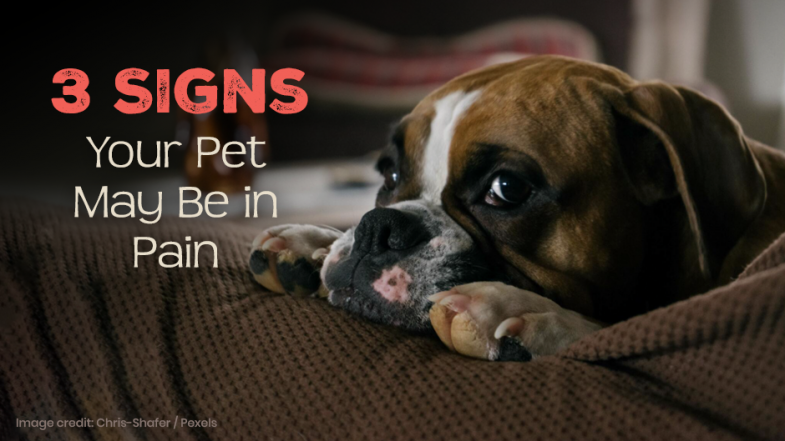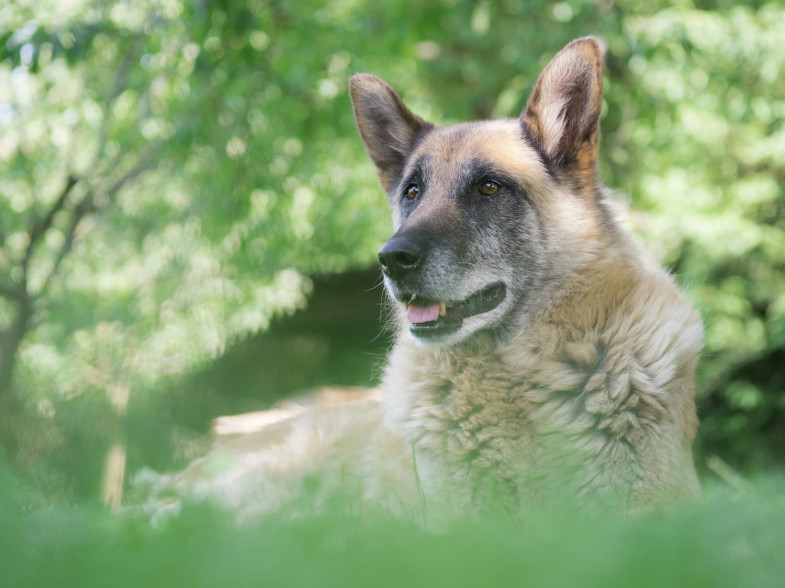Steckelberg Vet Clinic Blog
3 Signs Your Pet May Be in Pain

It crosses every pet owner’s mind: “Is my pet in pain?” And this question comes up more and more as our pets get older. One of the most difficult things about being a pet owner is that our pets cannot verbalize how they’re feeling. This leads us to wonder if our dogs and cats are living their best lives. The last thing you want is your pet struggling with chronic or acute pain, after all. And while your pet will likely never learn to speak human, they often send more subtle signs that they’re in pain. Here are 3 of the most common signs that your pet is in pain:
1. Changes in Behavior
It can be difficult to tell what is normal slowing down due to age for a dog or cat versus what is a change in behavior, activity level, or temperament due to pain.
What’s normal?
Partaking in games, affection, and fun but with less intensity. Many dogs and cats will also become more tired than they did when they were young. Sleeping more often between stints of activity is also normal.
What’s not normal aging?
If your pet’s attitude or interest in their favorite activities abruptly changes, there’s a very strong possibility they’re in pain. Discomfort and pain can make pets feel cranky and grouchy. It also zaps the fun out of playtime, snuggling, and receiving attention.
Many pets will tend to become more irritable over the course of the day. This is due to compounding aches and pains. There’s also a very good chance that if your pet is experiencing pain, they’re not sleeping well which adds to their crankiness.
Some pets may even growl or nip in response to pain. If you stroke your pet and they pull away or turn to nip you, you may have run your hand over a sore area.
If your pet loves snuggling on the sofa, but suddenly refuses to hop up, they’re likely not feeling their best.
2. Obsessively Licking One Area of the Body
Both dogs and cats will obsessively groom an area that is bugging them. The most obvious reason they do this is that they’re surveying and cleaning the area. Secondly, the tongue massages the tissues and increases blood flow to the area for a better immune response.
Not only does licking stimulate more blood flow to an area of discomfort, but it also releases ‘feel good’ endorphins in your pet’s brain.
You may notice your pet licking their paws and joints. This may be due to arthritis pain or over-exertion and soreness. Many dogs and cats will also paw at itchy painful eyes or ears.
3. Difficulty Eating or Lack of Appetite
If your pet loses interest in their meals, they are very likely not feeling well. Injuries can immediately cause a dog or cat to not want to eat. This is part of their fight or flight mentality as a response to pain.
Disinterest in food can be a sign of internal illness, as well. Many hidden conditions can cause a pet to feel lousy, which makes them lose interest in food. The most common internal conditions include:
- Parasites
- A strain or broken bone
- Allergies
- Tumors
- Infection
- Organ problems
- Possible poisoning
- An autoimmune disorder
Oral pain will also cause a reluctance to eat. If your pet skips a few meals or begins eating but stops, check their mouth for broken or chipped teeth. It can be difficult to tell what you’re looking at when it comes to your pet’s mouth, so be sure to make an appointment to see us.
Don’t Let Your Pet Continue to Deal with Pain
If you believe your pet may be in pain, please do not wait to schedule an appointment. Many of the signs we’ve listed could be symptoms of a worsening, severe, or life-threatening issue. We can diagnose your pet and provide the most advanced pain management and treatment.
Proactive preventative care, including dental cleanings, parasite prevention, exercise, regular checkups, and a healthy diet are the building blocks to your pet’s good health. We’re here to help you on this journey.
Categories
Recent Posts

If you're lucky enough to have a senior pet, you know just how special that bond becomes over time. From cozy afternoons on the couch to the look in their eyes that says, "I've known you forever," there’s a deep and quiet understanding between you. As pets get older, though, their needs change. Aging isn’t a disease, but it does require us to adapt how we care for our beloved companions.

Have you ever walked into a veterinary clinic, had your pet whisked gently away, and wondered who all those smiling, scrub-wearing professionals are? You might recognize your pet's veterinarian, but chances are there’s another key person working hard behind the scenes (and sometimes right beside you).

Did you know that pets accidentally start nearly 1,000 house fires every year in the United States? It’s a scary thought, but it doesn’t have to be a reality in your home. Our furry companions are naturally curious and love to explore their surroundings, but sometimes their adventures can put them, and your entire household, at risk. The good news? With a little awareness and a few easy changes, you can protect your pets and keep your home safe from fire hazards